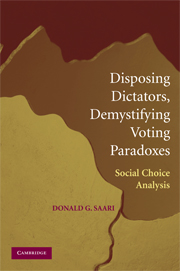4 - Explaining All Voting Paradoxes
Published online by Cambridge University Press: 24 May 2010
Summary
To find a medical cure, we first must understand what causes the problem. Similarly, to find good news for voting rules, we first must understand why all of the election inconsistencies occur. Doing so has several advantages; it identifies how to handle the dreaded curse of dimensionality, and it suggests how to discover which voting rules best represent the “will of the voters.” The latter goal, of course, requires establishing a reasonable definition for the elusive “will of the voters.”
To motivate my approach, let me repeat a description (e.g., Saari [74]) about my nonexistent consulting business.
For a price, I will come to your organization before your next election. You tell me who you want to win. After talking with each member of your group, I will design a “fair” election rule (i.e., all candidates will be considered, and it will be acceptable to the voters). The candidate you want to win will win.
To illustrate this boast, let me pose a challenge concerning an election for a new chair. Of the fifteen members in a department, suppose
Five prefer Ann ≻ Barb ≻ Connie ≻ Deanna ≻ Elaine ≻ Fred
Five prefer Barb ≻ Connie ≻ Deanna ≻ Elaine ≻ Fred ≻ Ann
Five prefer Connie ≻ Deanna ≻ Elaine ≻ Fred ≻ Ann ≻ Barb
It is easy to find ways to elect Connie; use the Borda Count or the vote-for-three rule. But how would you elect Fred?
- Type
- Chapter
- Information
- Disposing Dictators, Demystifying Voting ParadoxesSocial Choice Analysis, pp. 123 - 189Publisher: Cambridge University PressPrint publication year: 2008

